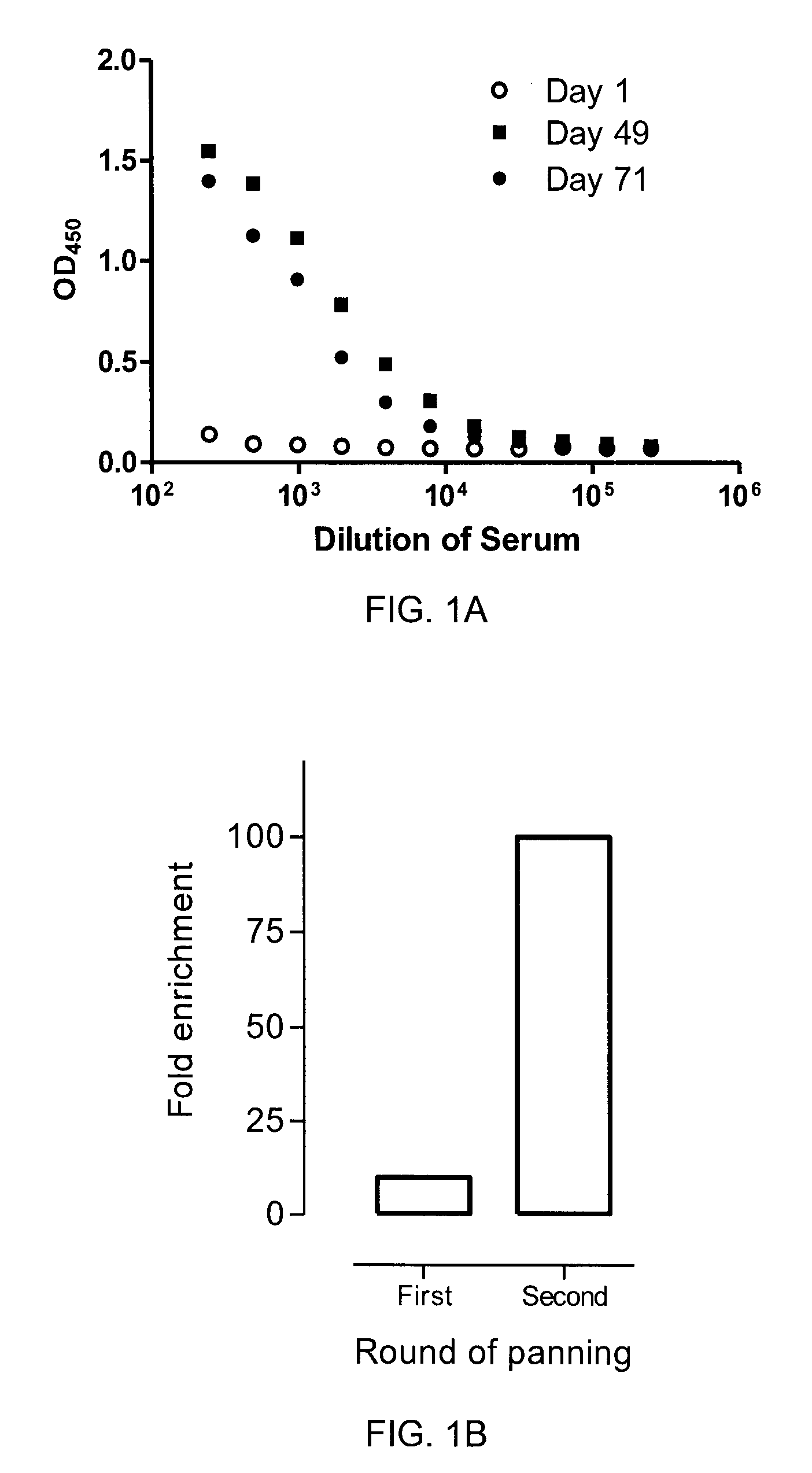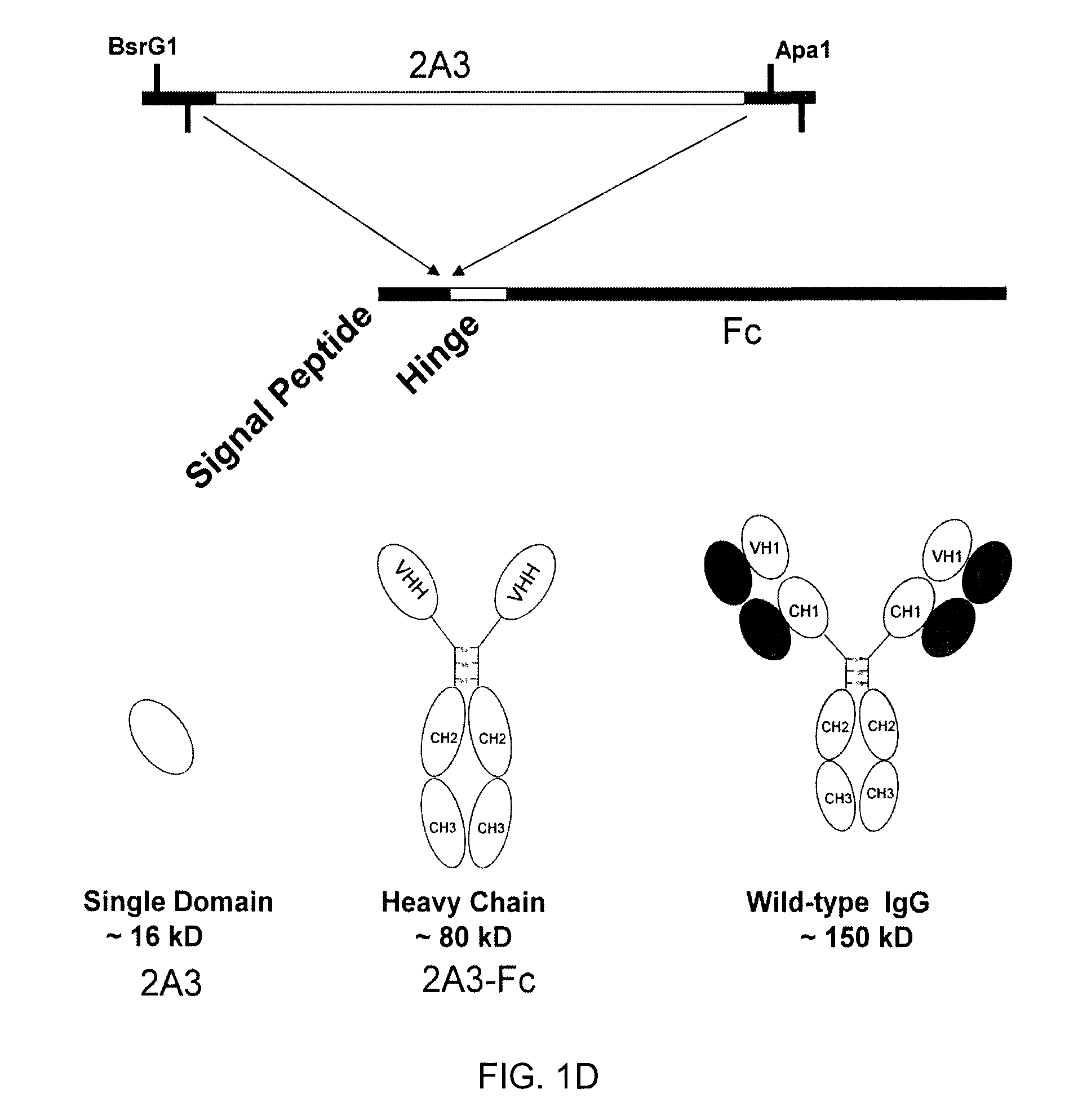Anti-CEACAM6 antibodies and uses thereof
a technology of anti-ceacam6 and antibodies, which is applied in the field of anti-ceacam6 antibodies, can solve the problems of difficult production, difficulty in engineering, and inability to produce promising anti-angiogenesis agents used in therapeutic trials to treat pancreatic cancer, and achieves fast tumor uptake and high expression of ceacam6. , the effect of high fluorescence intensity
- Summary
- Abstract
- Description
- Claims
- Application Information
AI Technical Summary
Benefits of technology
Problems solved by technology
Method used
Image
Examples
example 1
Cell Culture
[0106]Human small cell lung carcinoma cell A549, human colon cancer cell LS174T, and human pancreatic cancer cell BxPC3 were obtained from the American Type Culture Collection (ATCC), and murine breast cancer cells JM01 were obtained from Dr. M. O'Connor (National Research Council of Canada, Montreal, Canada); the cells were cultured in DMEM, EMM, RPMI, DMEM (Invitrogen, Carlsbad, Calif.) media, respectively, supplemented with 10% fetal bovine serum (FBS, Roche). Human head and neck squamous carcinoma cell line UM-SCC-22B was obtained from the University of Michigan and maintained in RPMI 1640 medium supplemented with 10% fetal bovine serum (FBS) and 1% glutamine. Human umbilical vein endothelial cells (HUVECs) were obtained from Invitrogen and were cultured in Medium 200 (Invitrogen) supplemented with 15% complement inactivated FBS and 2% low serum growth supplement (Invitrogen). All of the cell culture media contained 100 units / ml penicillin and 100 μg / ml streptomycin....
example 2
Isolation of sdAb
[0107]Single domain antibodies (sdAb) were generated by immunization of a llama and subsequently isolated.
[0108]One llama (Llama glama) was immunized five times (days 1, 21, 35, 49, and 63) subcutaneously with 1×107 whole cells from each of the four cells lines of Example 1. Complete Freund's adjuvant, incomplete Freund's adjuvant and no adjuvant was applied to the first, the second to the forth, and the fifth immunization, respectively. On days 1, 22, 36, 49, 64 and 71, 50 ml blood was collected from which sera and peripheral blood lymphocytes were isolated. An antigen-specific immune response against CEACAM6 was observed at both day 49 and day 71 compared to pre-immune level (FIG. 1A), despite the fact that purified recombinant CEACAM6 was never used for immunization of the llama.
[0109]RNA was extracted from peripheral blood lymphocytes using QIAamp RNA Blood Mini Kit (Qiagen, Mississauga, ON). cDNA was synthesized using First-Strand cDNA Synthesis Kit (GE Healthc...
example 3
Expression of sdAb
[0117]The sdAb 2A3 (Example 2) was subcloned into an expression vector for protein production and purification. The engineered 2A3 sdAb includes the ompA signal peptide as well as c-myc and His tags, and comprises the sequence:
[0118]
(SEQ ID NO: 16)MKKTAIAIAVALAGFATVAQAQPAMAQVKLEESGGGLVQAGGSLRLSCRTSGRTNSVYTMGWFRQAPGKEREFVAQIMWGAGTNTHYADSVKGRFTISRDSAESTVYLQMNSLKPEDTAVYYCAANRGIPIAGRQYDYWGQGTQVTVSSGQAGQGSEQKLISEEDLNHHHHHH
[0119]The sdAb 2A3 was subcloned in the expression vector pMED2 (Arbabi-Ghahroudi et al, 2009) using the restriction enzyme SfiI. After sequence confirmation, recombinant sdAbs were expressed as 6×His-tagged protein in the periplasm and purified by IMAC using a Ni-NTA column. Briefly, clones were inoculated in 25 mL LB with 100 μg / ml ampicillin and incubated at 37° C. with 200 rpm shaking overnight. 20 mL of the culture was transferred to 1 L of M9 medium (0.2% glucose, 0.6% Na2HPO4, 0.3% KH2PO4, 0.1% NH4Cl, 0.05% NaCl, 1 mM MgCl2, 0.1 mM CaCl2) supple...
PUM
| Property | Measurement | Unit |
|---|---|---|
| concentration | aaaaa | aaaaa |
| concentration | aaaaa | aaaaa |
| pH | aaaaa | aaaaa |
Abstract
Description
Claims
Application Information
 Login to View More
Login to View More - R&D
- Intellectual Property
- Life Sciences
- Materials
- Tech Scout
- Unparalleled Data Quality
- Higher Quality Content
- 60% Fewer Hallucinations
Browse by: Latest US Patents, China's latest patents, Technical Efficacy Thesaurus, Application Domain, Technology Topic, Popular Technical Reports.
© 2025 PatSnap. All rights reserved.Legal|Privacy policy|Modern Slavery Act Transparency Statement|Sitemap|About US| Contact US: help@patsnap.com



